Famous as the birthplace of Jesus, Bethlehem is a small city in Palestine, whose residents are living with the severe inconvenience and economic impacts of a huge wall that Israel has erected. Not only does it impair residents ability to commute to work in Israel and the West Bank, it cuts many residents off from their own farm land. 🙁
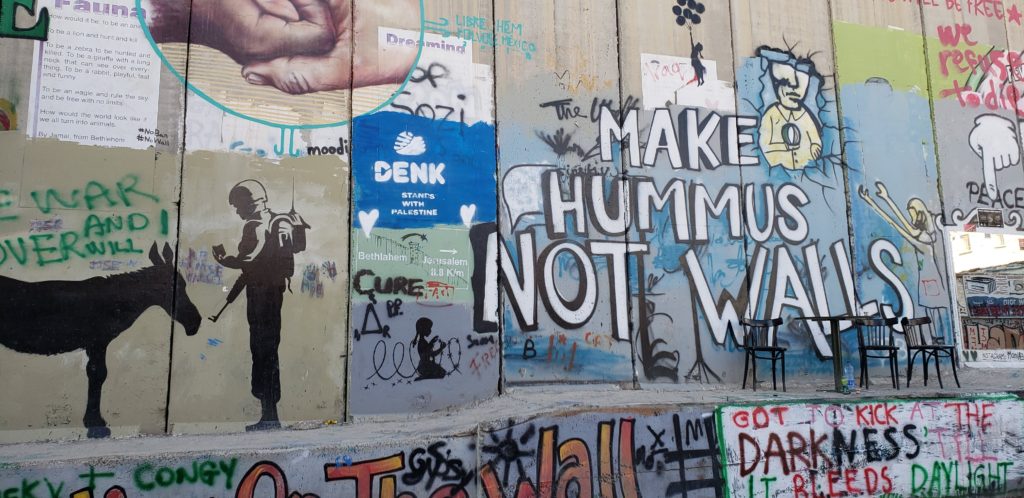
It is illegal for Israelis to travel to Bethlehem (or any other town in Palestine), but plenty of tourists make the short trip from Jerusalem (only 20 min bus ride from where we stayed). Judging by the enormous line of people waiting to see the grotto of the nativity – built over the stable where Mary gave birth to Jesus and laid him in a manger- it appears most tourists come to Bethlehem for a look at the holy place. We checked out the church (see below) but I was more taken by the wall and Banksy’s art around the city.
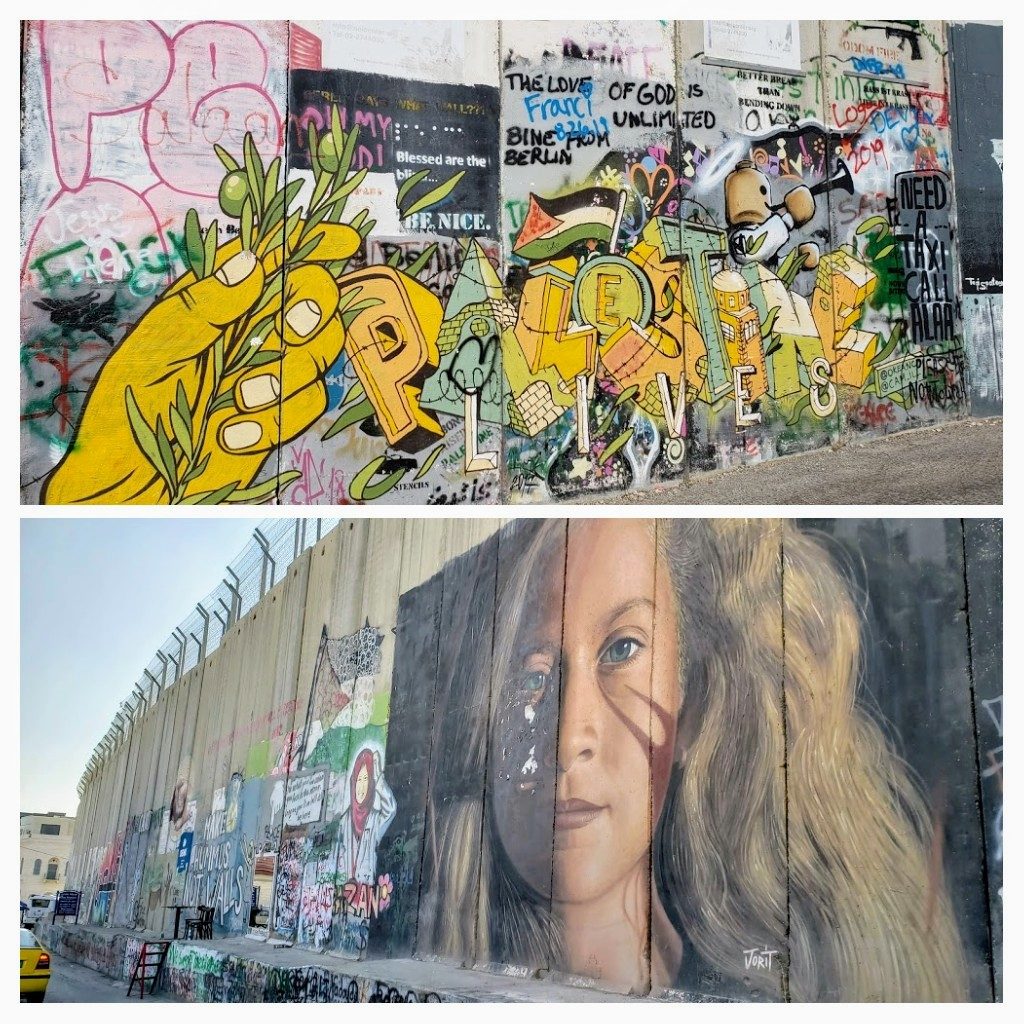
The wall we saw is part of the 810 km long West Bank Barrier. The West Bank (of the Jordan valley) is Palestinian territory, but since 1967 it has been under Israeli military occupation. The idea of creating a physical barrier separating Palestinians from Israelis had been around since Yitzhak Rabin was Israel’s Prime Minister in 1992, but building of the wall didn’t get underway until 2002. It has various names – the Israelis prefer ‘security fence’ while in Arabic it is called the ‘wall of apartheid’.
The restrictions the wall places on Palestinians in Bethlehem and elsewhere in the West Bank is sobering. Residents face difficulty trying to access education, healthcare, workplaces and cultural sites. They need to carry permits for all sorts of things (going to a funeral, a farmer accessing his own land, a permit for a doctor escorting a patient in an ambulance etc). The wall itself does not even follow the armistice / ‘Green line’ with 85% of it cutting into West Bank territory, sometimes by as much as 18km from the line. According to a 2005 UN report the West Bank land now on the other side of the fence – between the wall and the green line- is some of the most fertile in the West Bank. It is now inaccessible to Palestinians :(. Israel through this placement of the wall well inside the West Bank territory have annexed 9.5% of the total area of the West Bank to the Israeli side of the barrier.
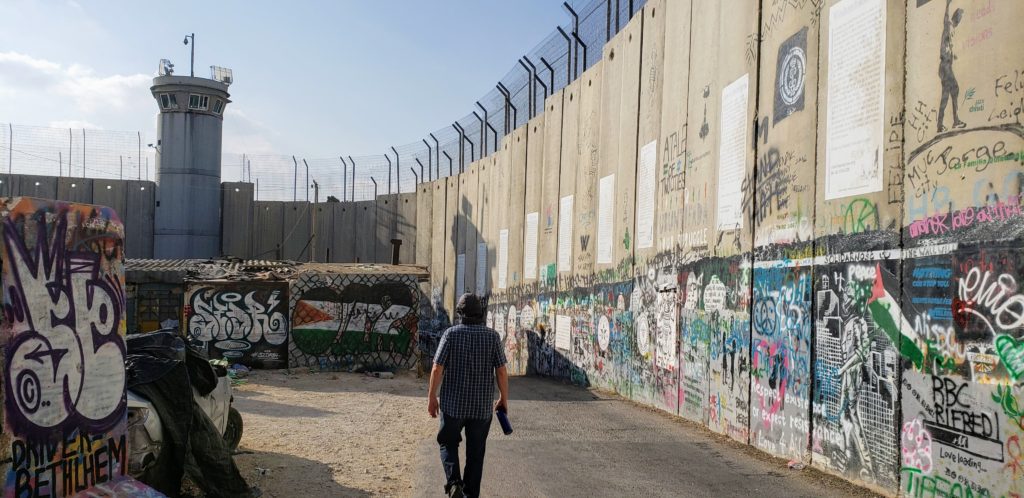
The International Court of Justice and the UN have stated the wall violates international law but just as the Israeli settlements have also been declared unlawful- nothing stops Israel from expanding them.
Water is in short supply for Palestinians in the West Bank, who rely on old pipes that leak about 30% of their water and who regularly face cuts to their water supply. Some people are surviving with just 10 L per day- which is SO little. For comparison – New Zealanders use an average of 227 L per day per person. Meanwhile, residents in the illegal Israeli settlements in the West Bank have their own water supply, enjoying about 400 L per day per person, which is plenty to spend on watering their lawns and filling their swimming pools. New Palestinian wells require a permit and the Israeli government vetoed every single application between 1995 – 2008 for wells drawing on the West Bank’s western basin’s mountain aquifer. I’m not sure if any have been allowed since then.
There is a lack of decent waste systems and sewage treatment in the West Bank plus Israel is disposing their toxic garbage here (where rules are more lax than in Israel). All this paints a very depressing picture of the Palestinian situation (and we haven’t even mentioned the troubled Gaza Strip)!
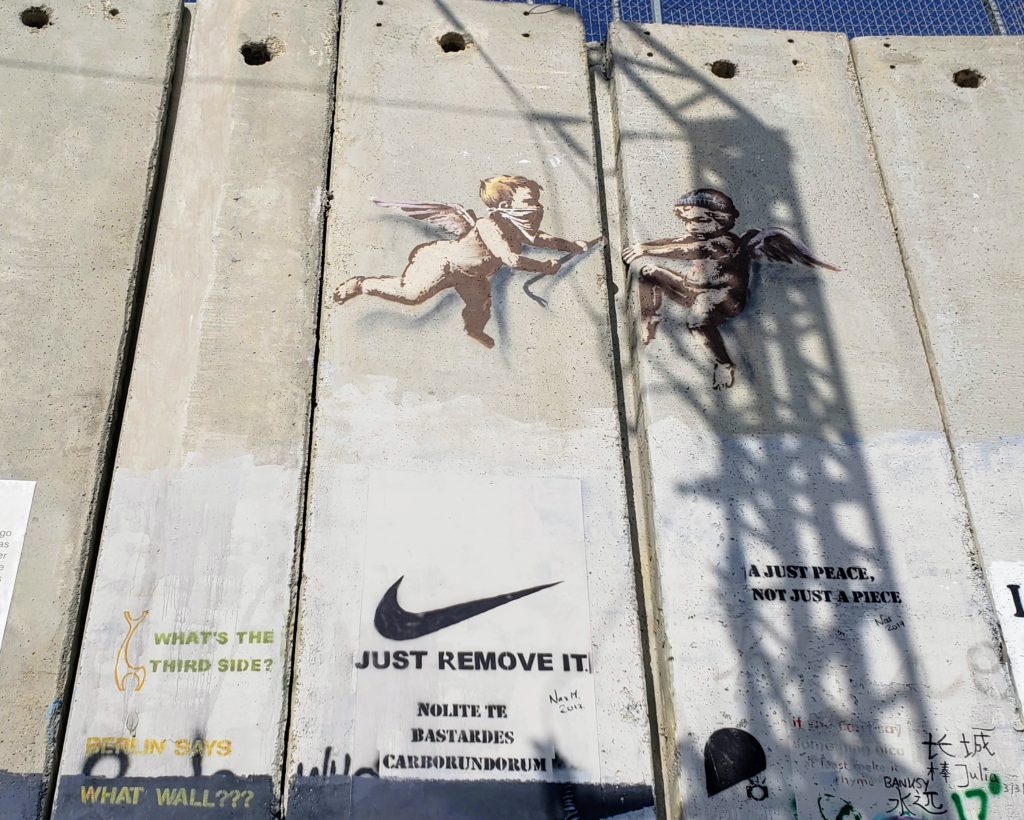
The British artist Banksy, empathising with the Palestinians, hoped his art around Bethlehem would speak to young Israelis as well as bring in tourists, to help stimulate the local economy and draw attention to the Palestinians’ plight. In 2017 he opened the Walled Off hotel, boasting rooms with the worst view in the world (i.e. of the segregation wall). Banksy’s involvement in Bethlehem has its admirers and critics and this is a good article covering both views.
We got a driver to take us to one of Banksy’s iconic pieces that was too far to walk to. It was huge – painted on the side of what looked like a truck workshop, on a random street, a guy who looks like he would be throwing rocks, throwing a bouquet of flowers.
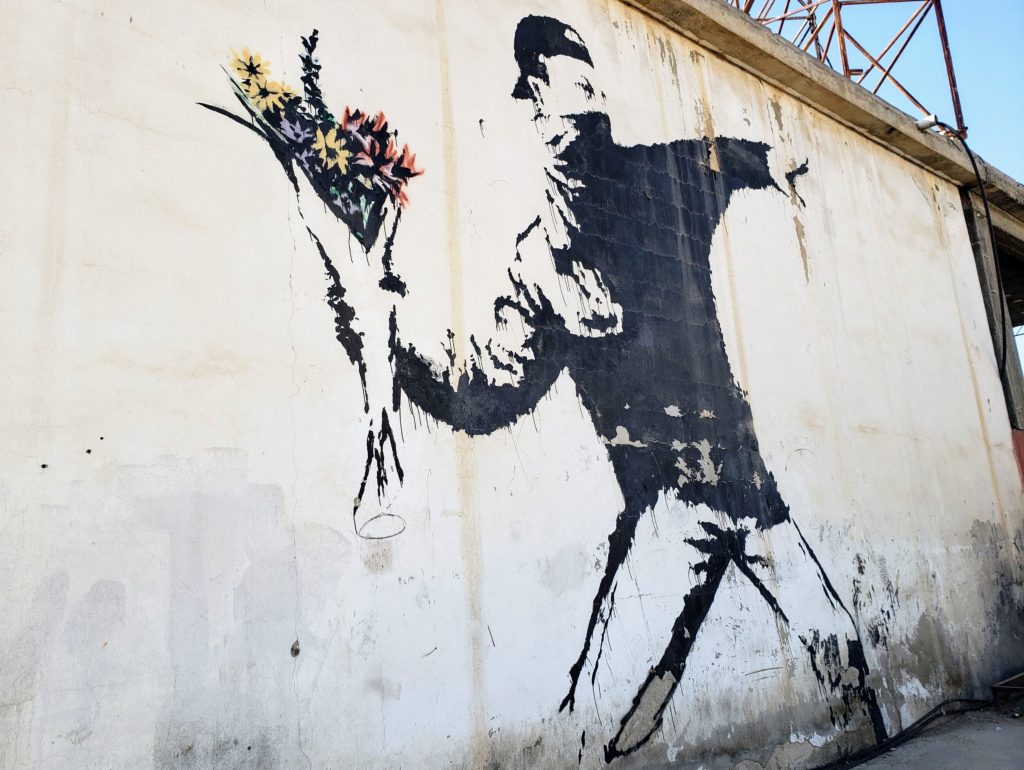
Most of Banksy’s works are on or close to the separation wall which itself had a lot of interesting art & graffiti on it, including copies of Banksy’s work from other places, like the donkey having his papers checked by the soldier in top photo.
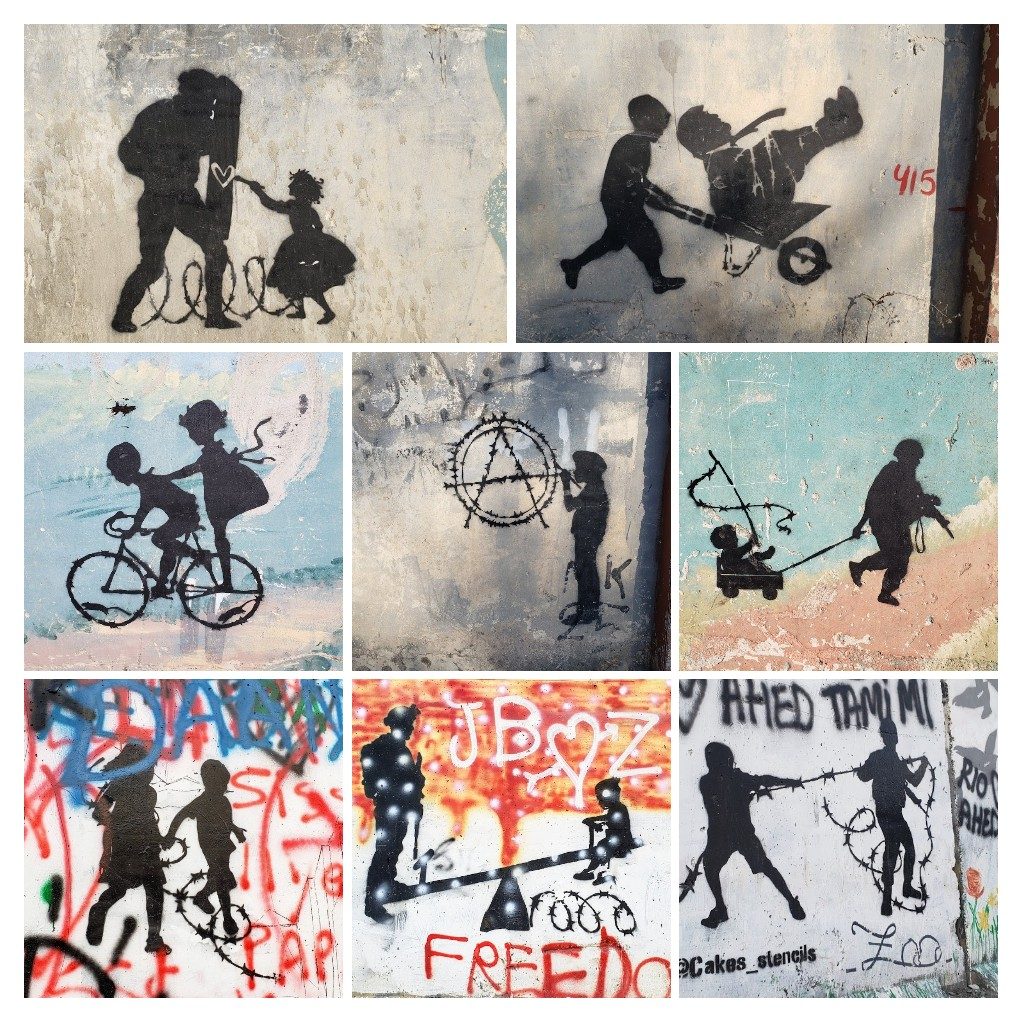
The famous Banksy picture of a girl frisking a soldier was on a random wall near the segregation wall but an enterprising local then built a shop in front of it so to view it you need to go inside his shop!

Banksy’s clever ‘Armoured Dove’ is near the Palestinian Heritage Cenre which is like a small museum and showcases locally made handcrafts and souvenirs.
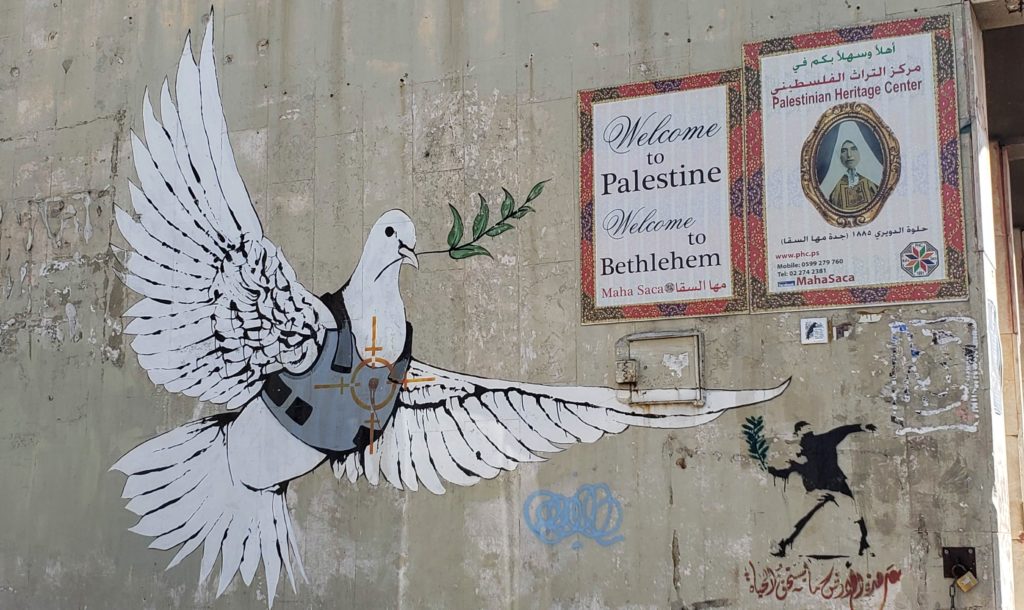
I had hoped to find some handmade Christmas decorations here as that is one of the few things we buy as souvenirs in the places we visit, but alas they had none. When I asked if they had any they pointed me to a shop a few doors down. With huge plastic santas at the door and lots of plastic crap inside, it wasn’t exactly what I had in mind!

We went into Banksy’s Walled Off Hotel right beside the wall which housed a free art gallery showcasing Palestinian artists and a small but informative museum that told the story of the wall and the depressing situation for Palestinians in the West Bank and Gaza.
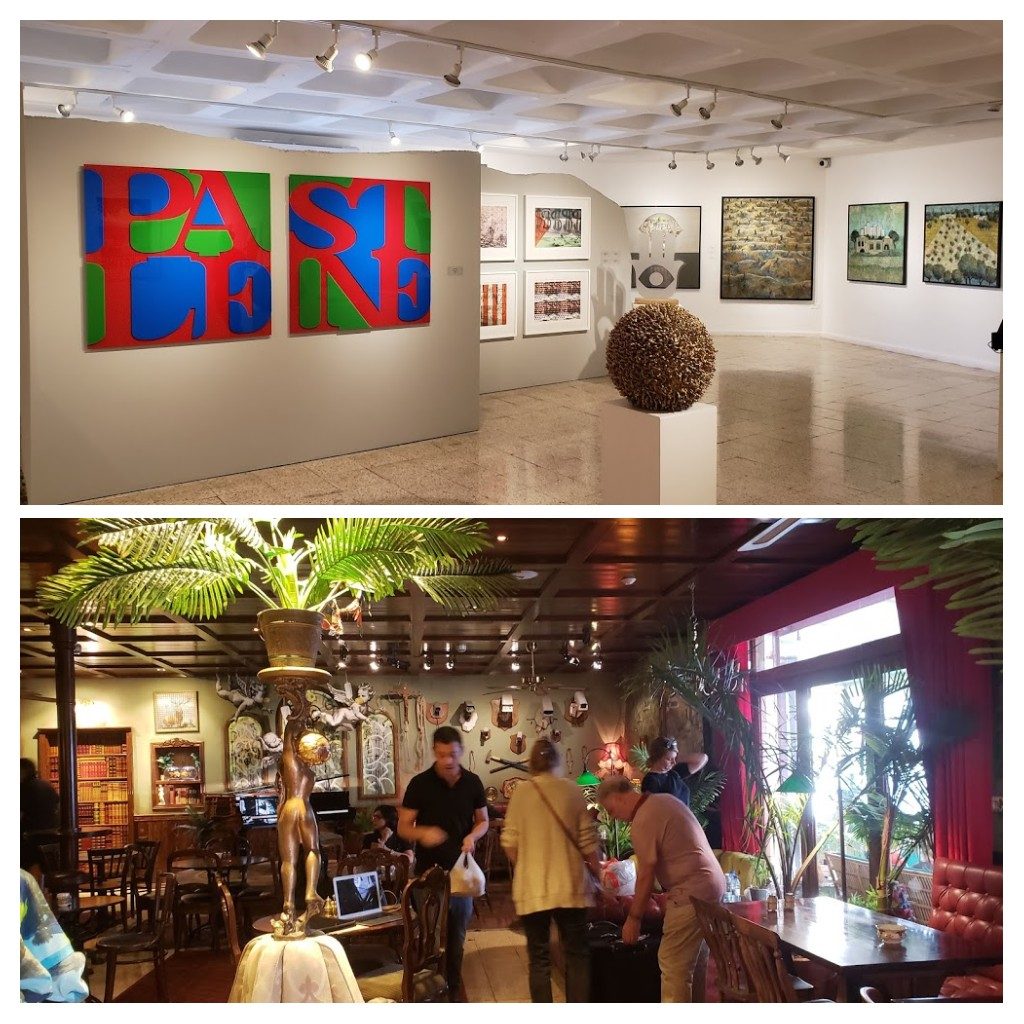
A couple of things stood out for me in the musuem, firstly what Israel has deemed a threat to their national security. This includes 18 dairy cows that the Israeli army then pursued! This is no joke and told in the animated documentary film The Wanted 18. Just as strange is the refusal to let sewing machines, goats, fishing rods, fabric, spare parts for tractors, paper and pens into Gaza because of their possible ‘dual use’ as military weapons. Following international pressure, Israel agreed in 2010 to let in fizzy drink, jam, shaving cream, spices, chips, biscuits and sweets!
The information about house demolitions shocked me the most I think. It noted that in 2016, Israel seized or destroyed 1000 Palestinian structures, affecting 8000 people. Demolitions are carried out by the army with explosives and armoured bulldozers with residents given about 15-30 minutes notice to save their belongings. Sometimes this is via a phone call or text message. Other times they drop a less destructive bomb on the roof to let the people inside know the place will soon be destroyed so they have 5-15 minutes to get out. This is called ‘roof knocking’ and the Israeli military claims this meets their wartime humanitarian obligations to civilians. The UN doesn’t agree. All these demolitions have been ruled illegal under the Geneva Convention.

The quotes the museum has from residents (displayed in Arabic and English) give a good insight into the impacts of the wall on regular people. Below are some more of those quotes if you are interested in getting a sense of the implications on daily life.
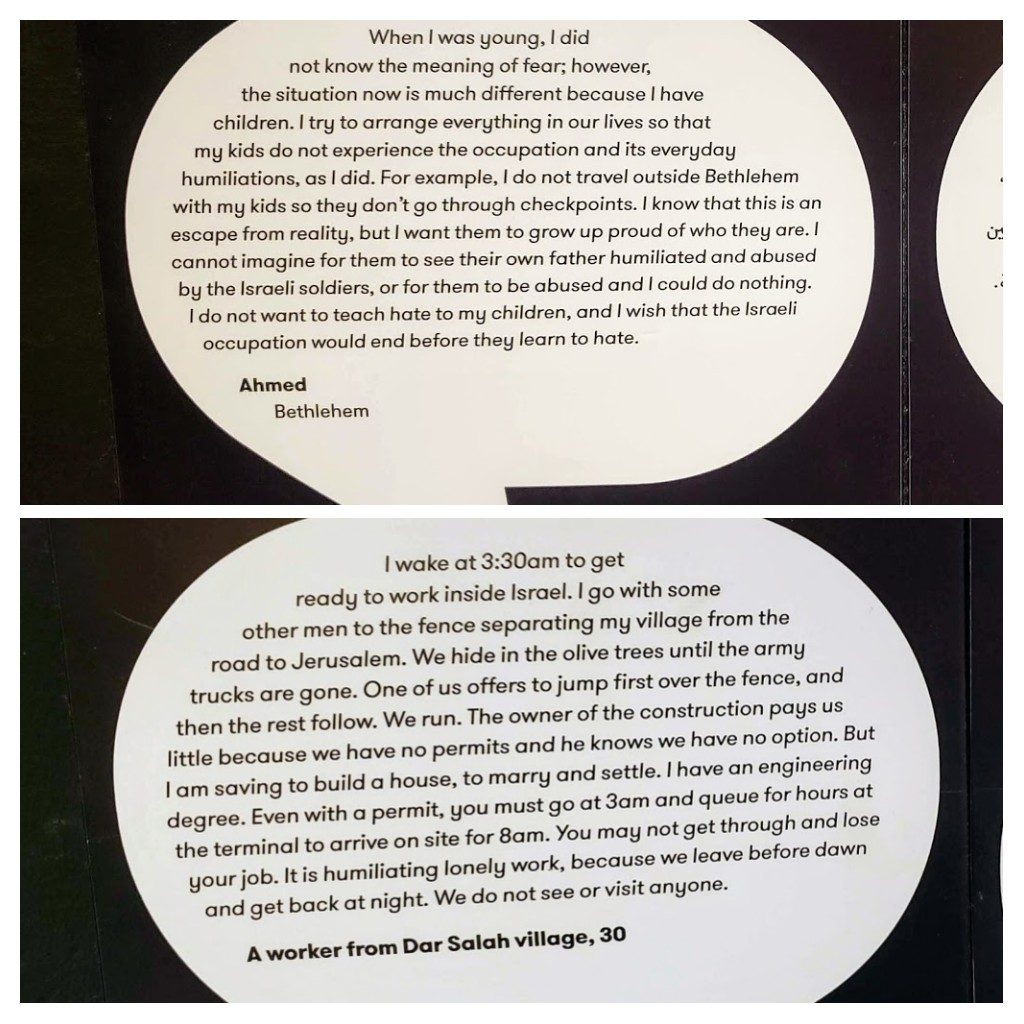
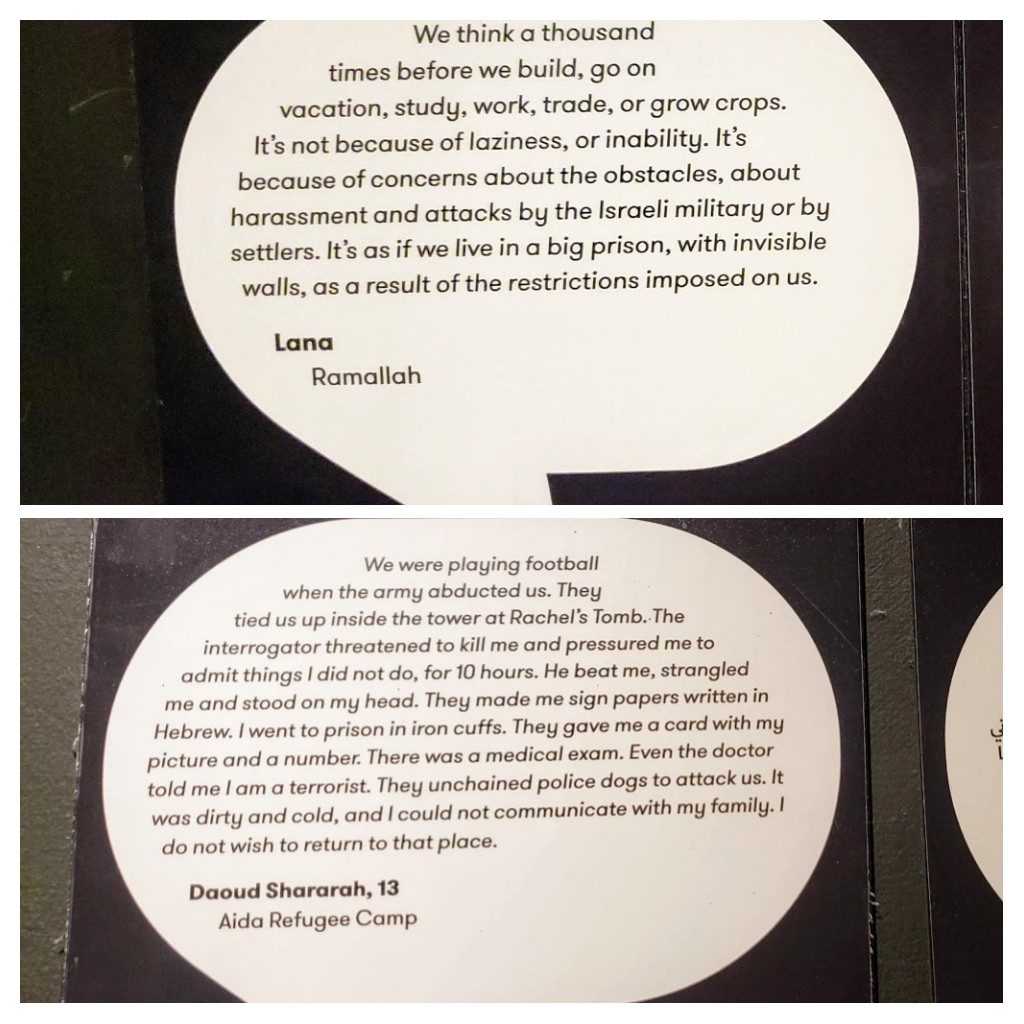
The last quote above is from a 13-year old boy from Aida refugee camp. This is more like a suburb of the city, near the wall. We visited this area and had a boy about the same age show us around. His father made interesting things out of empty tear gas cannisters and sold them in a little shop near the entrance.
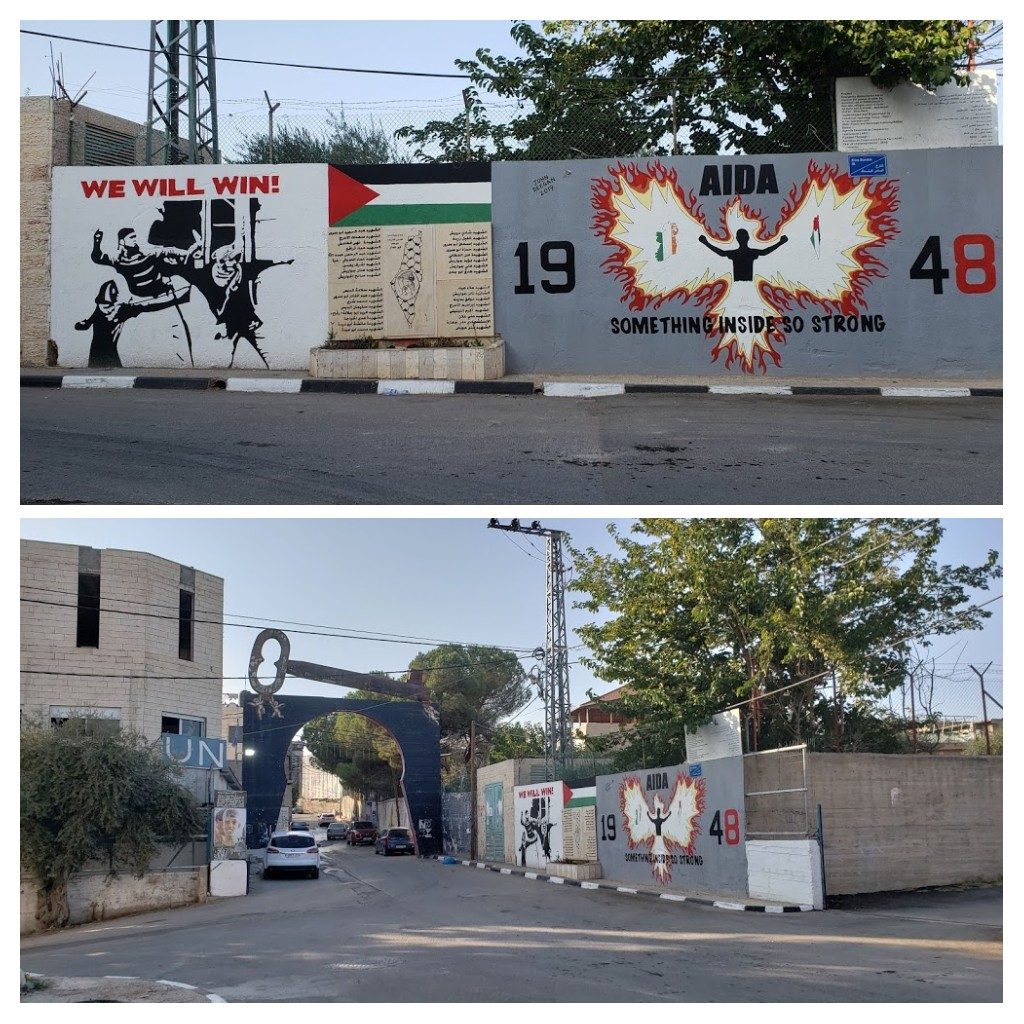
The refugee camp has become a permanent home for the many displaced people who live here. The building code (if there is one) does not appear to be adhered to at all, as people have belatedly added extra stories to buildings in haphazard fahion as space runs out in the camp. Some really dodgy looking building construction and really overcrowded housing here.
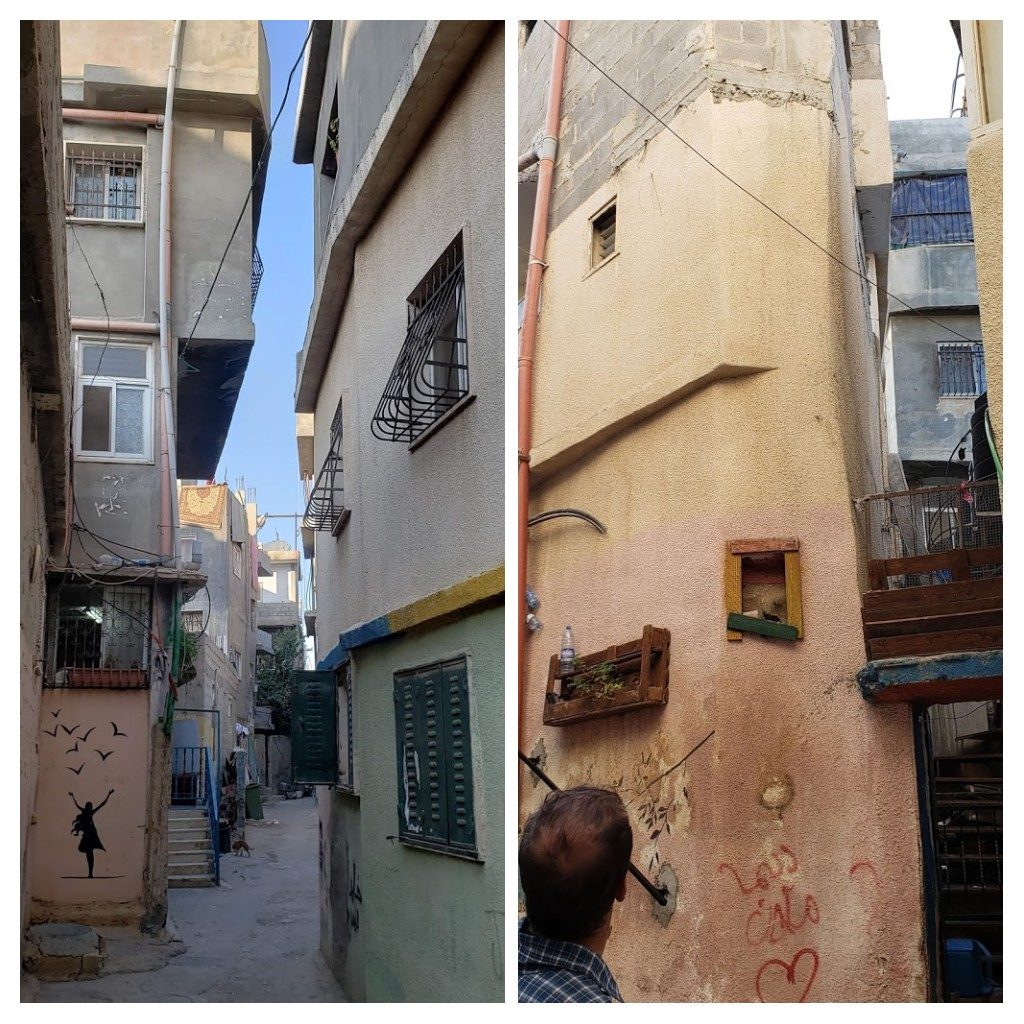
Our young guide showed us a mural of the history of those in the camp, made by locals with some help from European volunteers. It lists their home villages which were destroyed or taken by the Israeli military in 1948 forcing them to flee.

Parts of the mural showed what life was like before their lands were stolen and it conveys their hope of a return one day. About 710,000 Palestinian Arabs (60% of the population!) were forcibly removed from the territories that became the State of Israel in 1948. Today these people and their descendents live in refugee camps in the West Bank and Gaza and over 5 million live in exile abroad. They are still stateless and the oldest, unsettled refugee population in the world. The UN acknowledges their ‘Right to Return’ but the State of Israel does not.
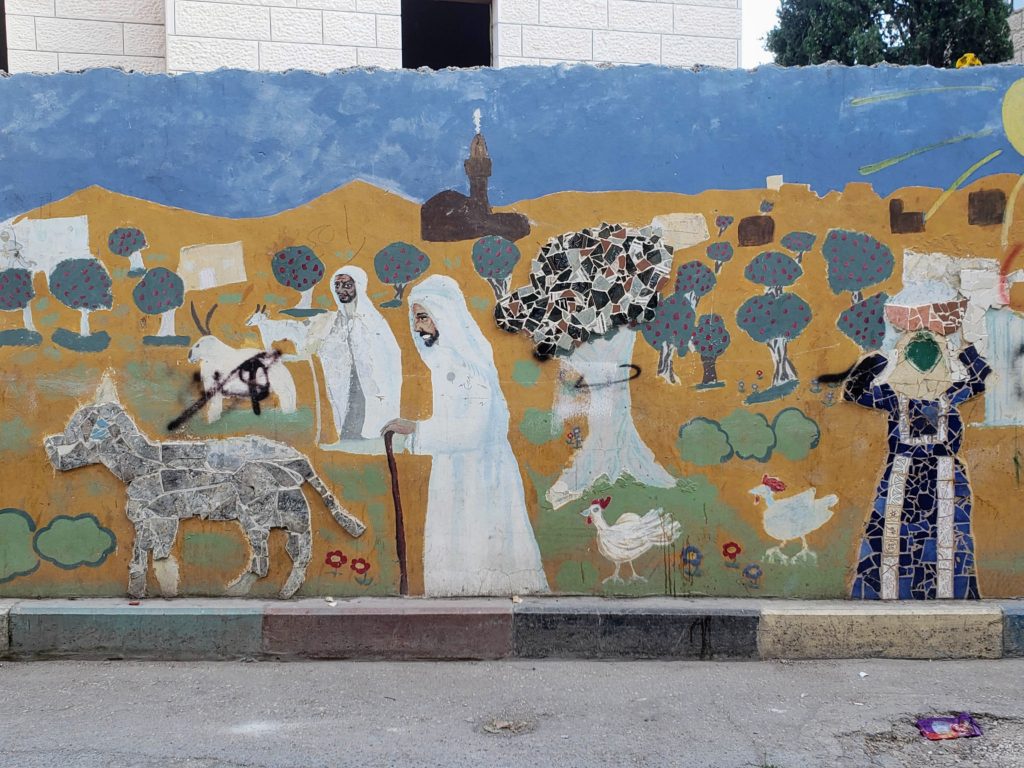
There were other pictures on walls around the camp including one of a boy who had been killed… and a list of names near the entrance to the camp of Palestinian children who were killed in 2014. Next to this one was a mural depicting Israeli soldiers and a Palestinian throwing rocks with the text in English ‘We can’t live so we are waiting for death’. All very depressing.
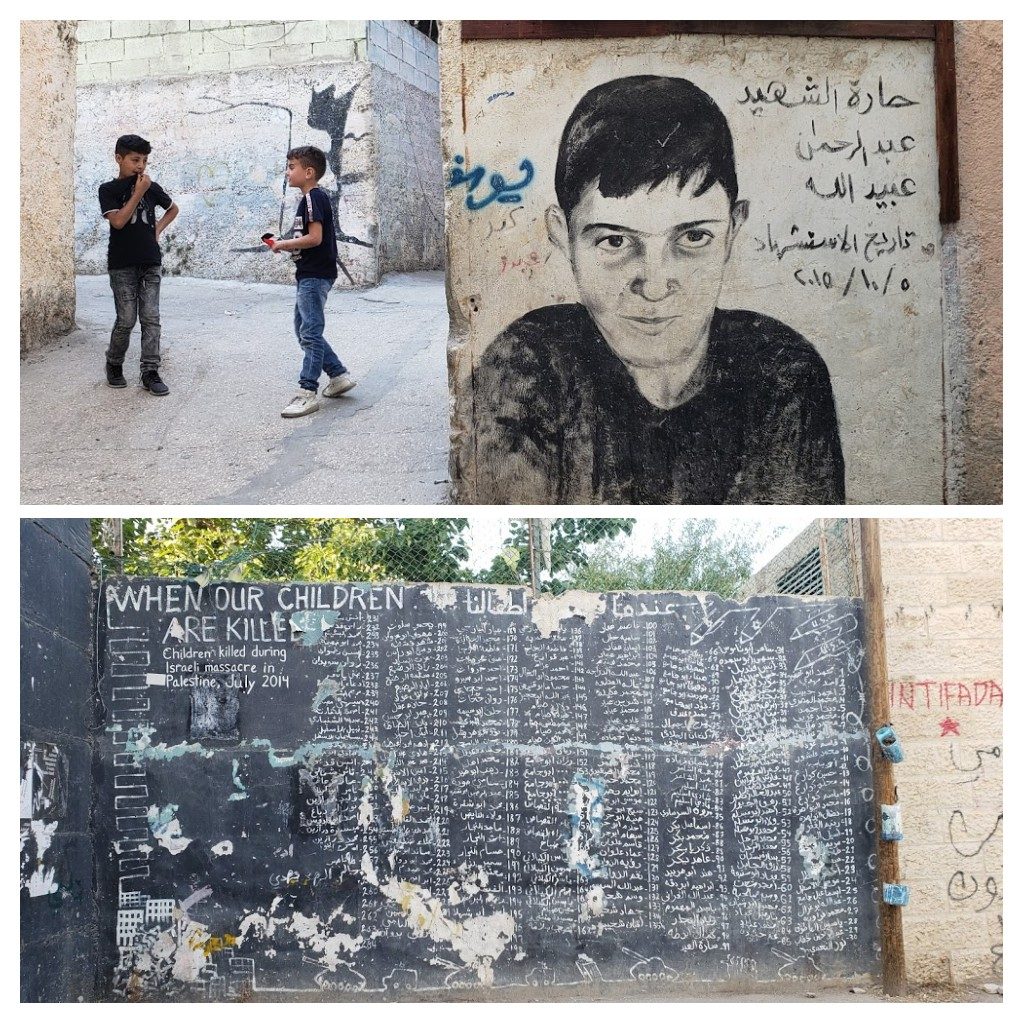
Right, moving on to something more chirpy… in the centre of town, Manger Square had a nice feel to it.
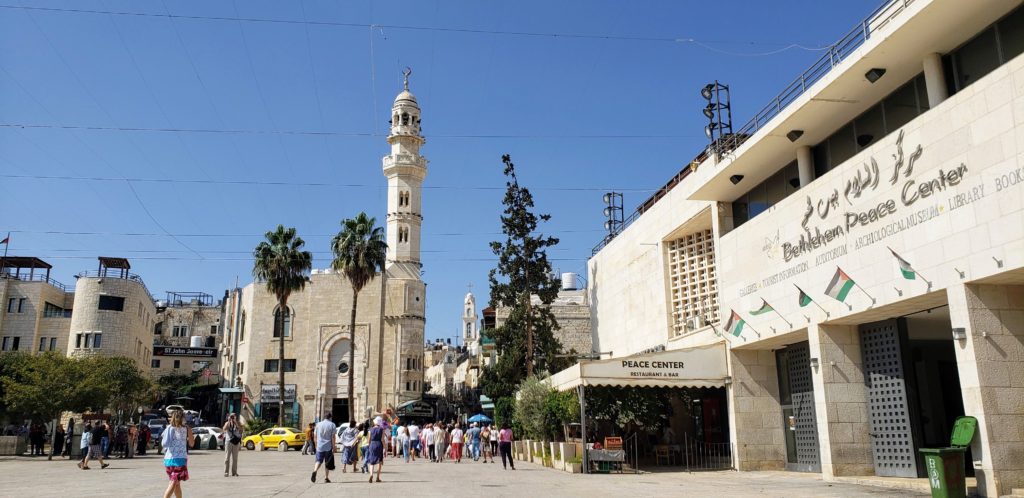
We visited the Church of the Nativity, a Byzantine basilica, built by Helena (Constantine’s mother) around 330 CE to commemorate Jesus’ birth. Originally it was an octagonal structure, on top of a cave where tradition says Jesus was born. The church was destroyed by fire and then rebuilt in the mid 6th century to its current form (with a few alterations and expansions since then). The grotto the church contains is the oldest site continuously used as a place of worship in Christianity. Because of its significance to so many, it is one of nine holy sites in Jerusalem and Bethlehem for which the 250 year old ‘Status Quo’ applies.
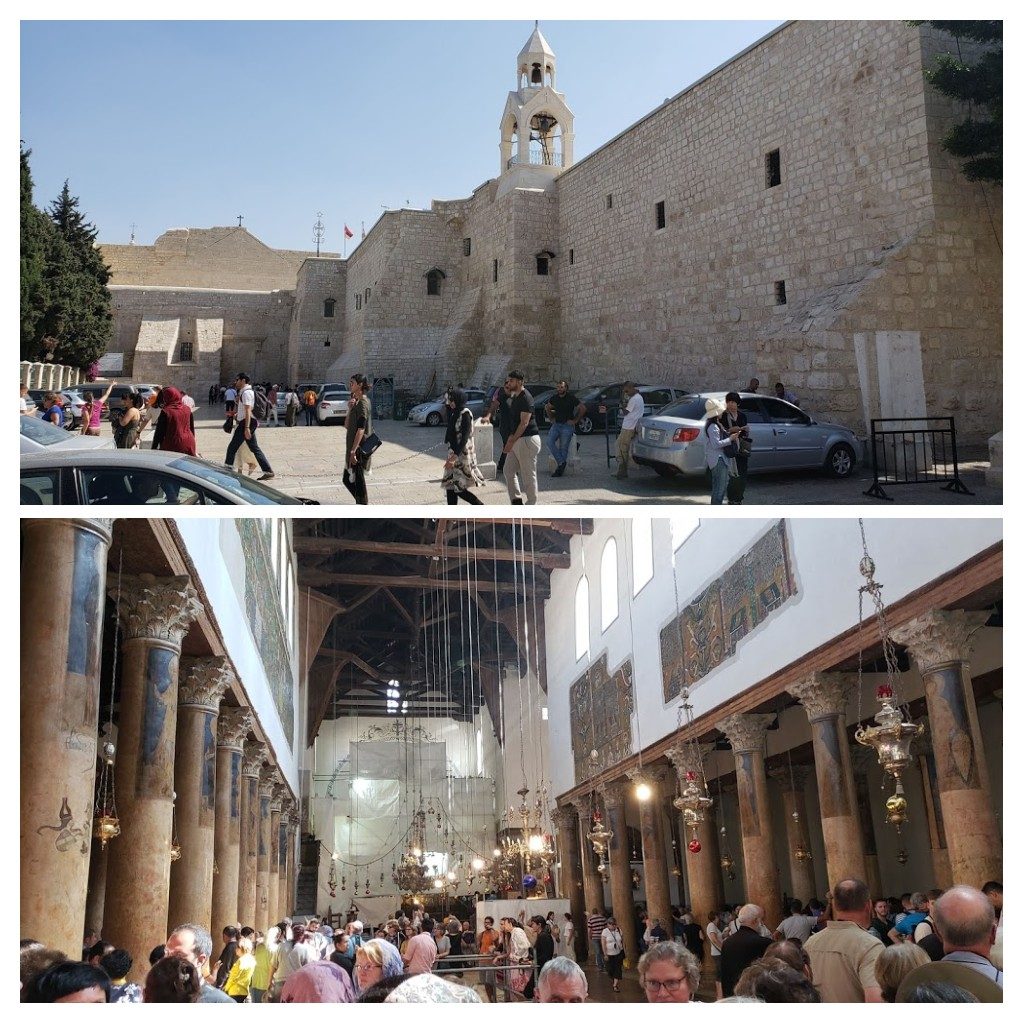
My favourite thing was the entry. There was no grand entrance, rather you had to stoop low to go through the small door! Although it’s named the Door of Humility, it was designed this way apparently to keep out the looters/ make it difficult for them to enter and exit with any treasures, rather than with humility in mind. Still it’s quite fascinating that such a holy place has a very insignificant entrance.
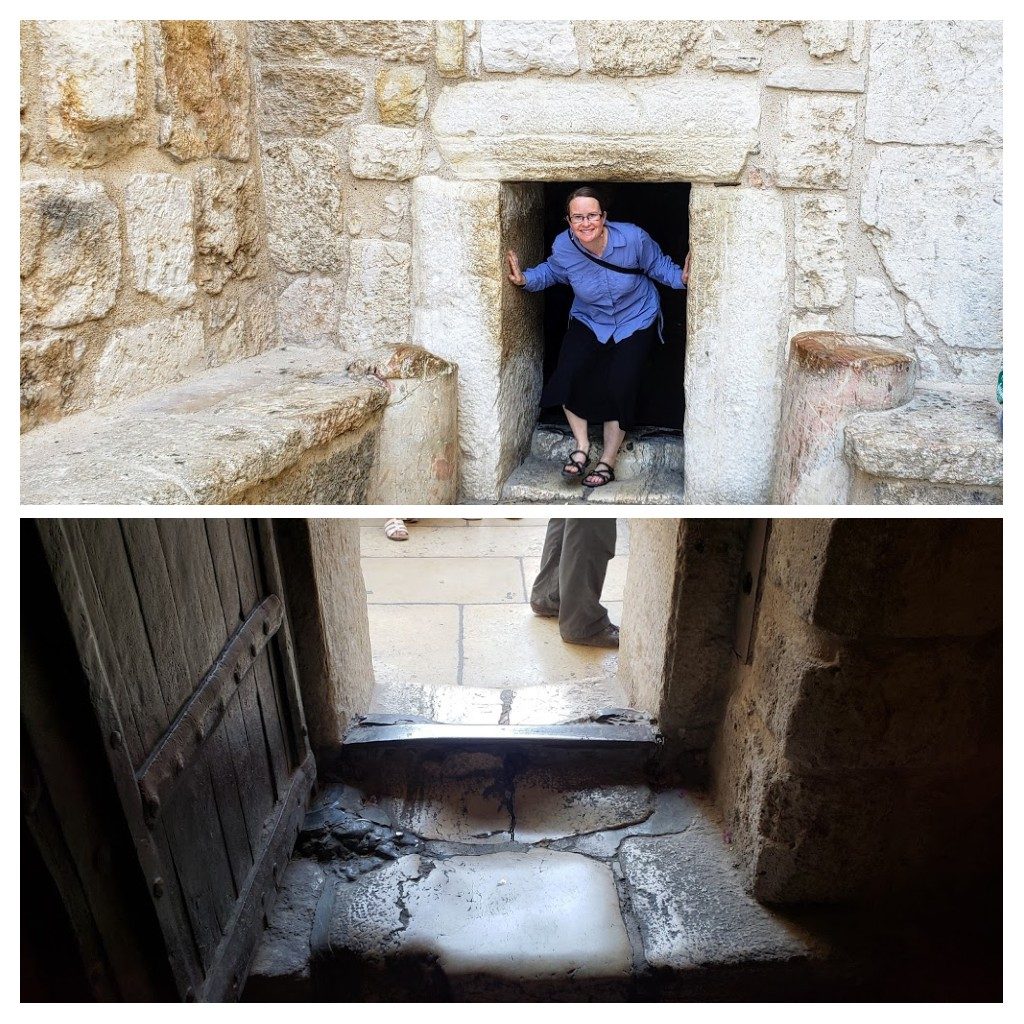
Inside there was a huge line waiting to enter the grotto – the part where Jesus is believed to have been born. It went all the way around the church and didn’t look to be moving very quickly. We weren’t that interested in waiting for hours in a line or paying a guide to jump the queue so we just enjoyed what we could see of the main church including some cool frescoes and mosaics. Most of the golden medieval mosaics that would have covered the walls have not survived, but those that have are beautiful. There were also floor mosaics visible from the original Constantian basilica, thanks to a trap door in the current floor.
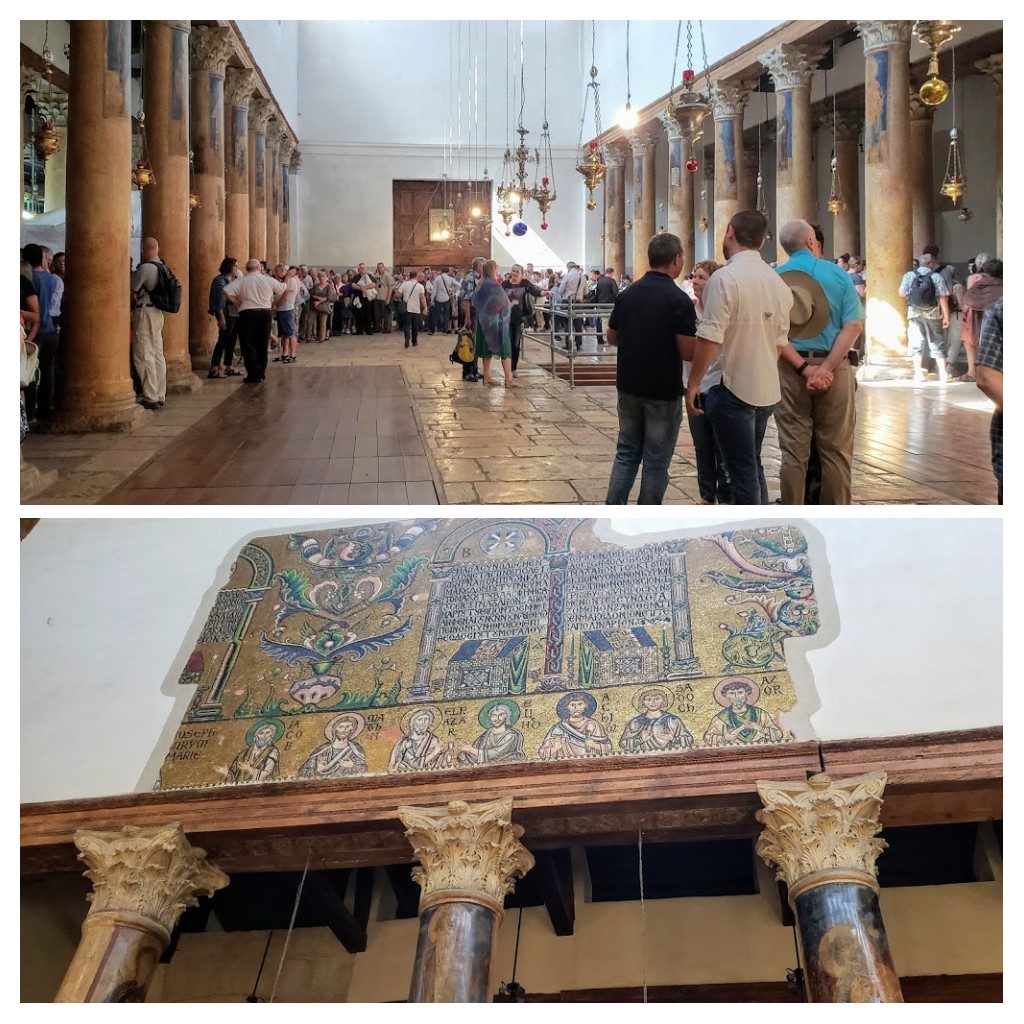
Then we headed through to the adjoining Roman Catholic church, St Catherine’s which works as a parish church and a Franciscan monastery, and hosts the Christmas Eve Midnight Mass.
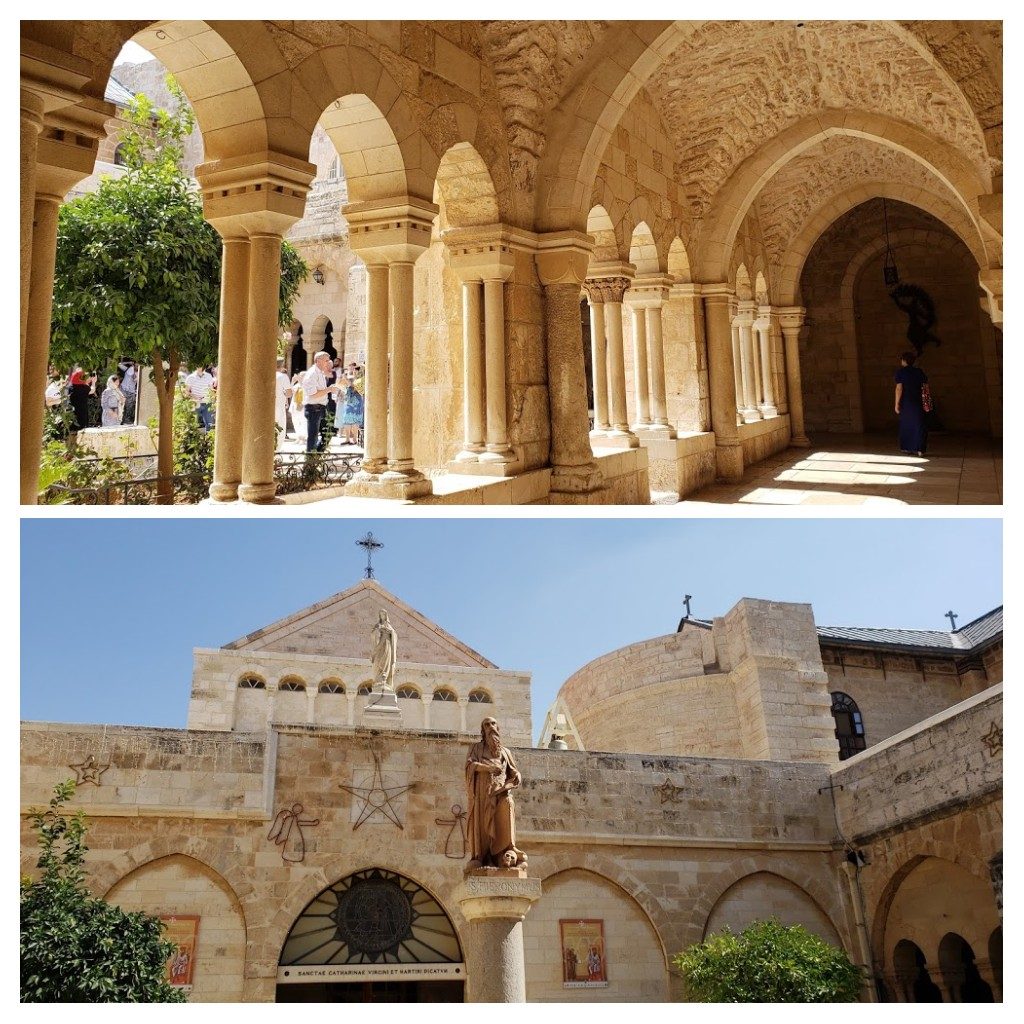
There are a number of underground chapels in caves you access from St Catherines, including a Chapel for Joseph commemorating the angel’s appearance to him commanding him to flee to Egypt and the Chapel of the Innocents – remembering the children killed by Herod. There were so many people in the Chapel of Saint Jerome I couldn’t see it properly. Tradition says Jerome lived in this underground cell while translating the Bible into Latin (the Vulgate). There is a tunnel from here to the grotto where Jesus was said to be born, but it is kept locked, only accessed from the Church of the Nativity.
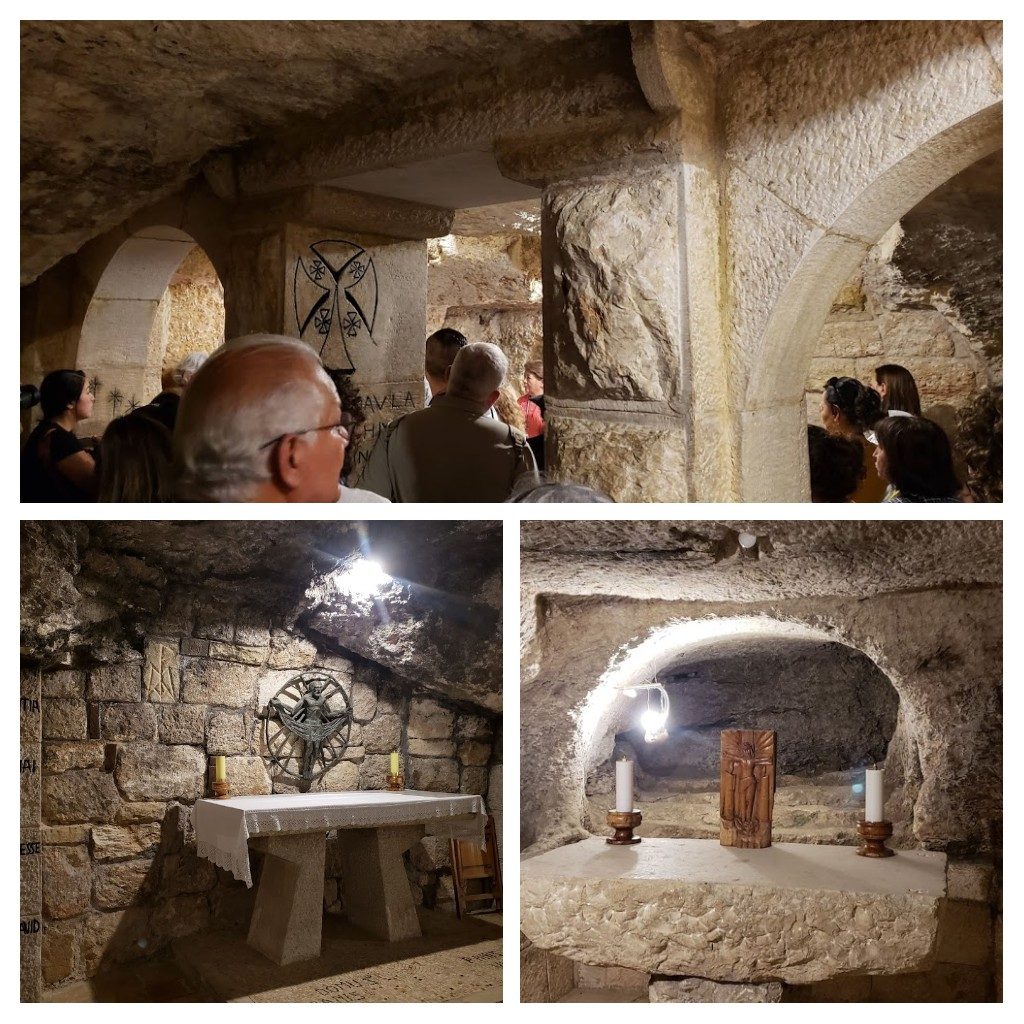
Around the corner from the Church of the Nativity was a small street leading up to the Chapel of the Milk Grotto which Christian tradition says is the place where Mary, Joseph and baby Jesus found refuge, before fleeing to Egypt when Herod had the command out to kill all boys under two. The ‘Milk grotto’ name is derived from the story that a ‘drop of milk’ of the Virgin Mary fell on the floor of the cave and changed its colour to white. Supposedly the shrine is a place where prayers for conceiving children are miraculously answered – so we didn’t linger!
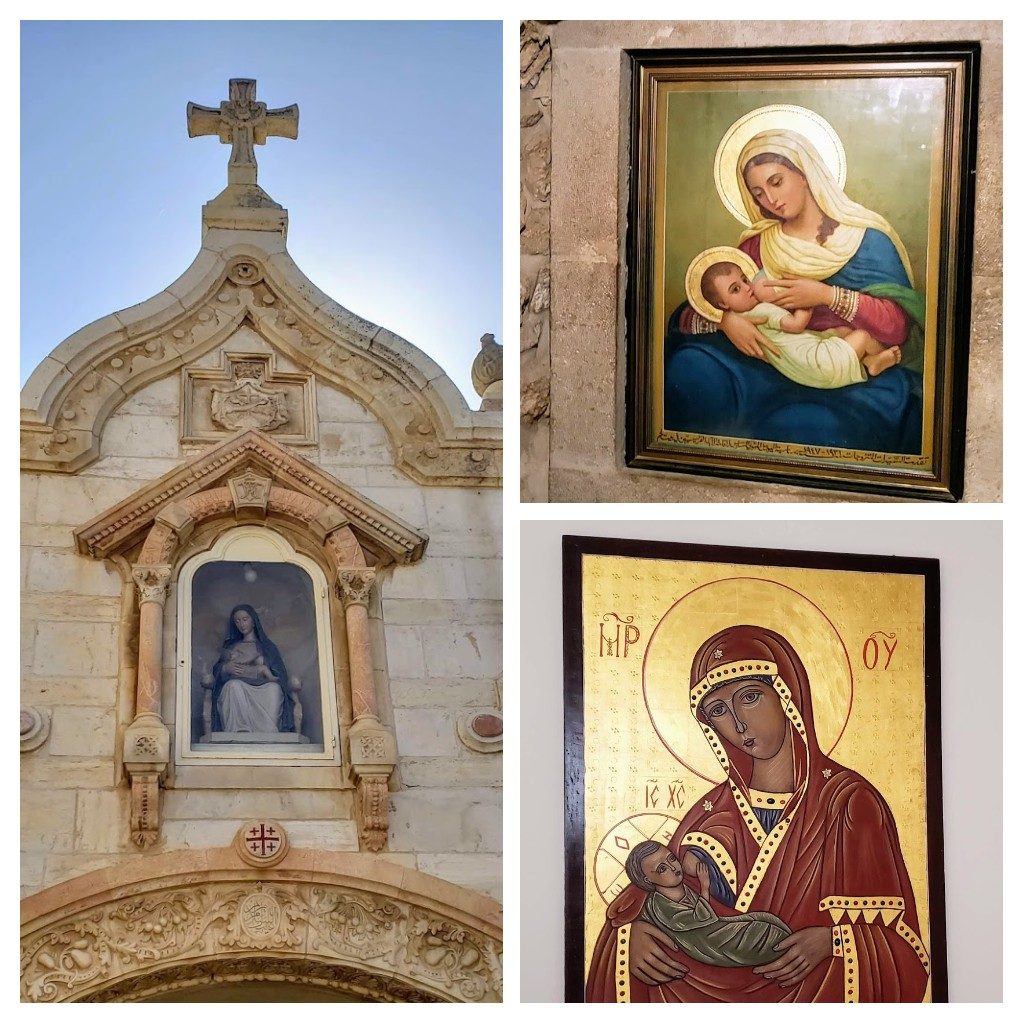
Mostly the church was filled with art depicting Mary breastfeeding Jesus. On this street there were a number of craftsmen creating Christmas decorations out of olive wood. We bought a few things here for ourselves and as gifts.
All in all it was a bit of a heart-touching visit to Bethlehem, not for any spiritual reasons, but more because we got a better sense of the day to day life Palestinians experience. The uncertainty and lack of freedom they have to contend with is really quite upsetting. How we take our freedom for granted in New Zealand!
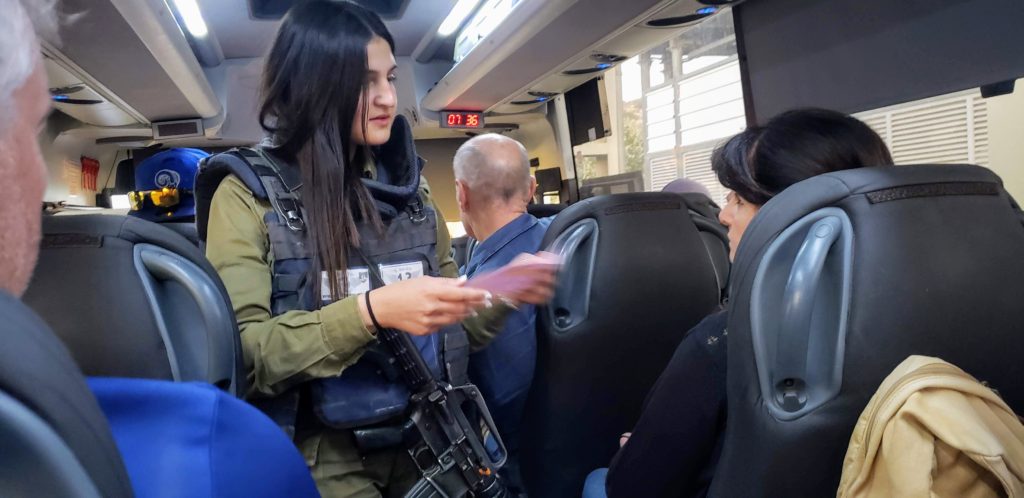
Not in Bethlehem itself but close by is the burial place of King Herod and the ruins of Herodium. Oh so humbly named after himself, Herod built Herodium in the 3rd century BCE to be a government and administrative centre in Judea. It was the largest complex of palaces in the Roman world at that time with 3 parts: 1 the mountain palace fortress, 2. Lower Herodium with an extravagant entertainment area and 3. the mountain slope on the northern part of which Herod built a ceremonial staircase, his tomb and a royal theatre.
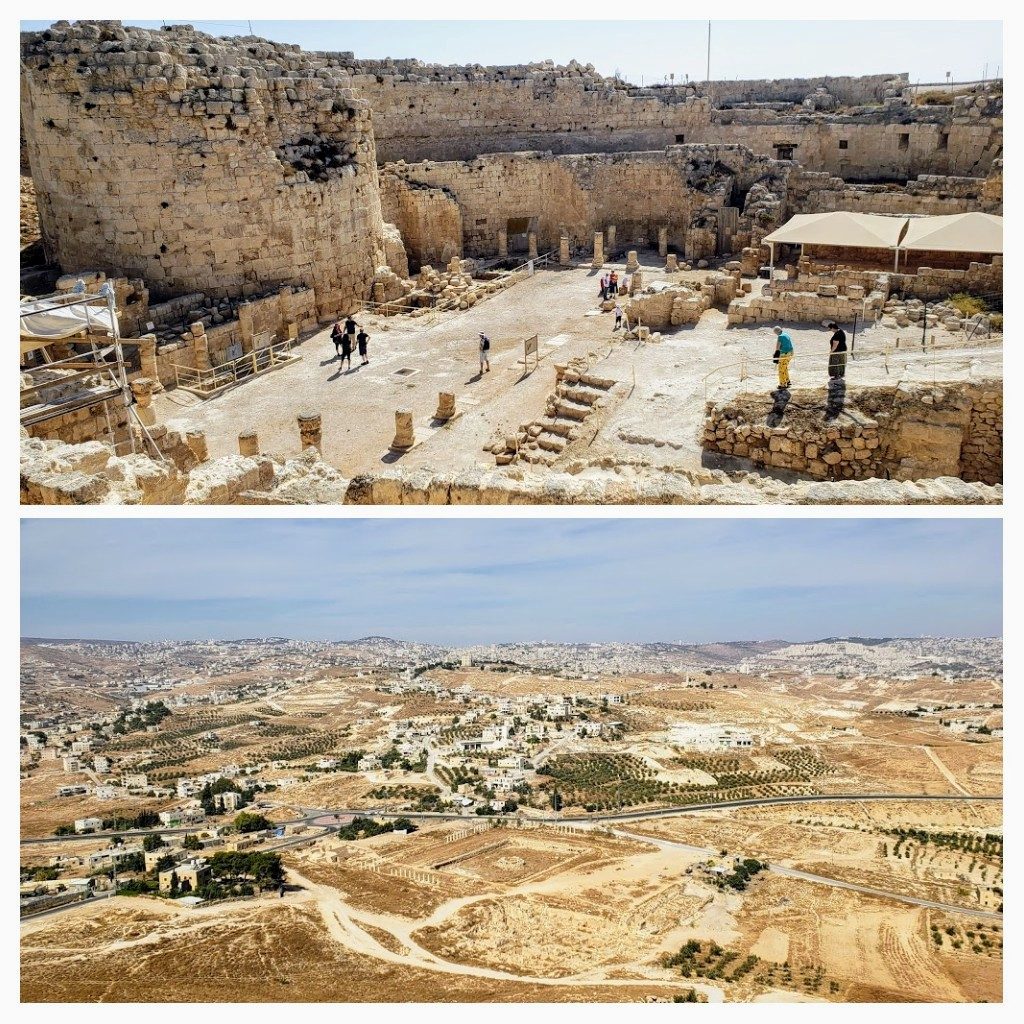
Herodium doesn’t take too long to see as most of what there is to see is up the top. We loved the views of lower Herodium (and the modern towns built nearby) but didn’t wander around there as it’s 15 hectares! We enjoyed exploring the mountain fortress palace with its tunnels, large cistern and intact dome ceiling in the bathhouse- the oldest in the country. We also saw ruins from a Byzantine chapel and monastery.
Some of the underground tunnels we explored were created in Herod’s time to access the cisterns, one is from the 1st century, allowing the rebels access to the water without being seen during the Great Revolt, and others are from the Bar Kohba revolt time (middle of 2nd century) leading to concealed exits through which the rebels could come out and surprise the Roman forces if they made it to the mountaintop.
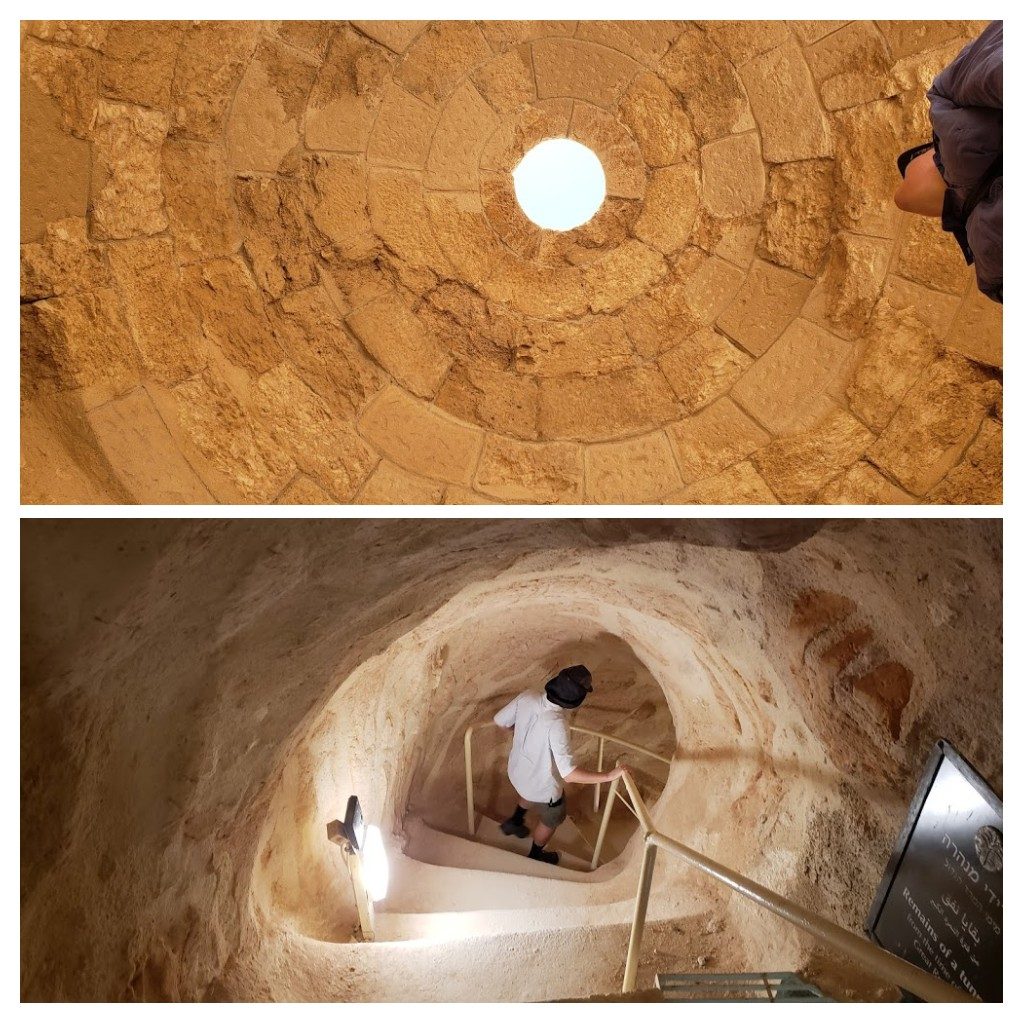
Ensuring he’d never be forgotten, Herod shortly before he died, had an artificial mountain built that could be seen for miles. Several features of the palace complex (such as the theatre, store rooms and mansions) were completely covered in order to create the gigantic cone. This was to draw attention to his tomb which faced Jerusalem and was approximately 25m high! Not much of it remains as it was razed to the ground during the Great Revolt and his stone coffin was smashed to pieces.
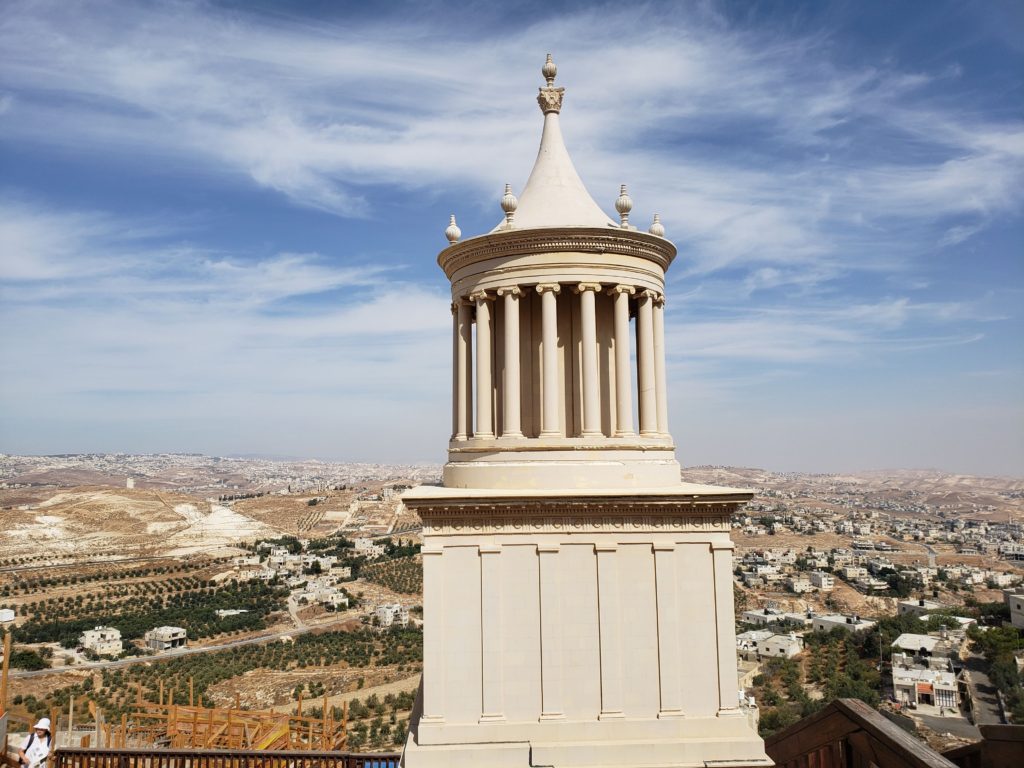
We actually visited Herodium the day before we went to Bethlehem but it can be combined in a single visit if you are happy to use a taxi and can find a driver who has permission to both travel in Israel and Palestine. We took a bus that went directly to Herodium from nearish our apartment (20min walk). We had planned on taking the bus back again after our visit but it was scheduled to only leave a couple of times a day and we didn’t feel like waiting in the middle of nowhere for a few hours in the hot sun for the next bus! A Korean woman was in the same situation as us and as we were discussing what to do a car came past and I stuck my arm out. A young man and his father had also just visited the site and said we could all get in and get a ride with them back to Jerusalem. Super kind!
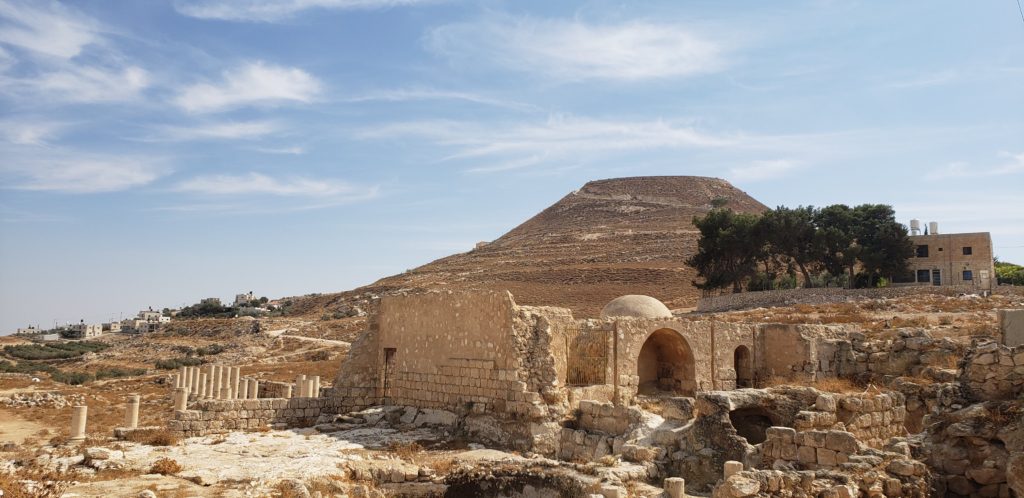
We drove back to Jerusalem through the Palestinian area on an Israeli access road. There were no road signs that identify the various Palestinian villages or towns we went past. These are banned in most of the West Bank, with only Israeli settlements named on the road signs. But the frequent red signs warning Israelis from entering indicated the turn-off to Palestinian towns.
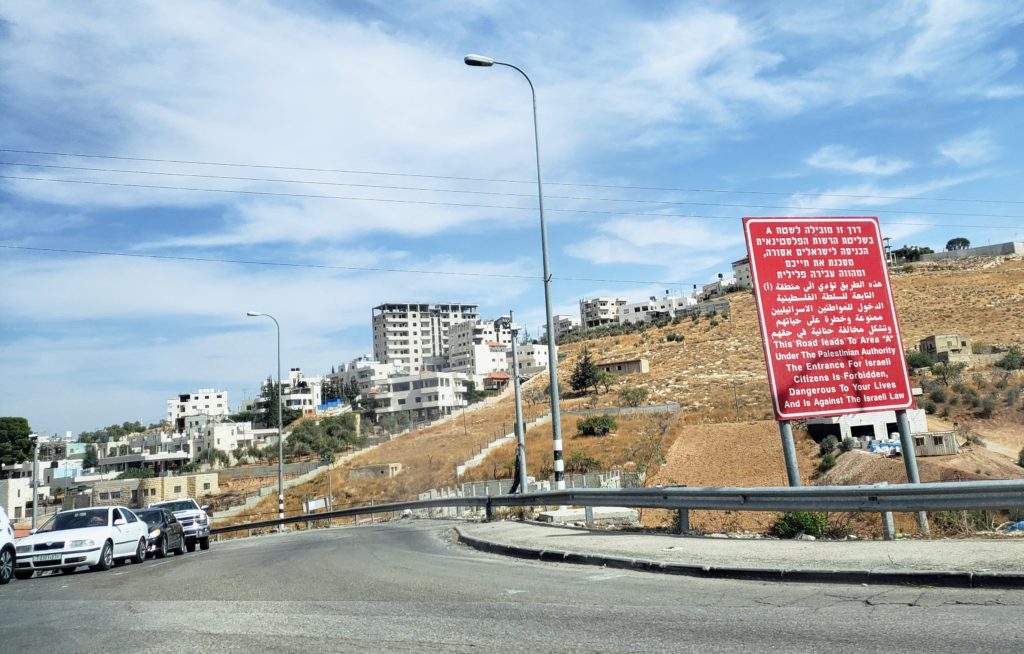
Like the 810 km West Bank Barrier wall, these signs are disturbing reminders of the segregation existent in this land and the fragile Palestinian situation.